Best astrophotography cameras 2024: Capture the cosmos
We've tested the best astrophotography cameras to help you capture the wonders of the night sky with ease — here are our favorite models ahead of Prime Day.
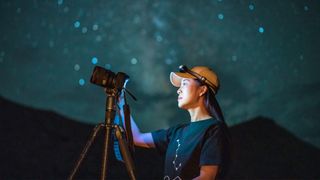
The best astrophotography cameras have certain features and specs that make them more suited to shooting in the dark than other models. As a baseline, they need to have excellent low-light performance, fantastic noise handling and a good battery life to avoid running out of juice on a cold night. Some models also have astro-specific features like Starlight View, Night Vision Mode and Starry Sky Autofocus — we've tested and highlighted all these features in each camera in this guide.
Once you've mastered the astrophotography basics, you can then invest in the rest of your kit a bit more — the best astrophotography lenses are typically wide-angle prime lenses to let ample light in, with the best tripods being sturdy and reliable. Experienced astrophotographers also make good use of lens warmers, star trackers and intervalometers. The best telescopes and best binoculars for stargazing can then provide you with an even closer look at the sky above.
We saw some fantastic Prime Day camera deals last year, so it's worth waiting until Prime Day on July 16/17 if you're looking to purchase one of the best astrophotography cameras.
The quick list
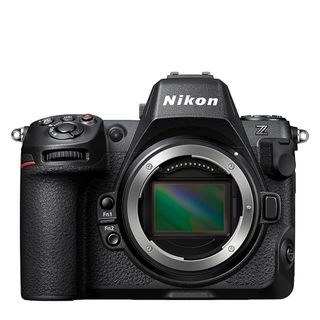
Best overall
Best suited to experienced and professional users, with a 45.7MP stacked sensor, and excellent low-light performance and some astro-specific features, we think the Nikon Z8 is the best camera for astrophotography on the market.
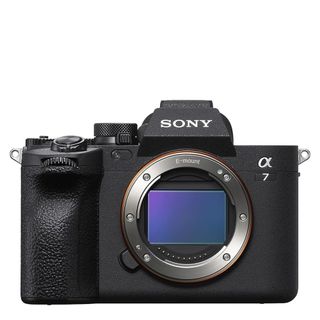
Best Sony
A welcome upgrade to its popular predecessor, the Sony A7 IV handles high ISO settings extremely well, has reliable autofocus and produces stunning 33MP images — we love it for a variety of photographic genres.
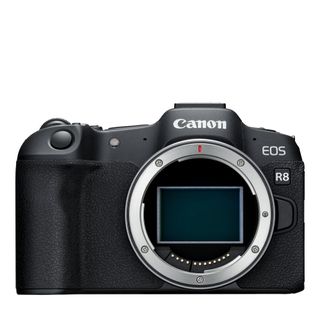
Best lightweight camera
As Canon's most lightweight camera at 0.91 lbs/414g, we think it's a perfect choice as a compact travel companion that can shoot a multitude of subjects and handle high ISO levels exceptionally well for astrophotography.
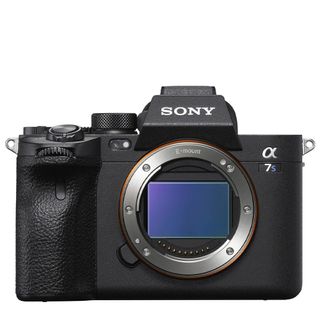
Best for video
The 12.1MP sensor may be a disadvantage for producing large, detailed prints, but it's a dream for astro shooting as fewer pixels mean less noise in your images and videos. We think it's best in class for video.
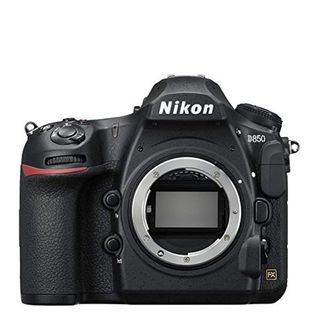
Best DSLR
Simply put, we think it's the best DSLR ever made — it can do it all. It has brilliant battery life, a super detailed 45MP sensor and some illuminated buttons to help you see in the dark.
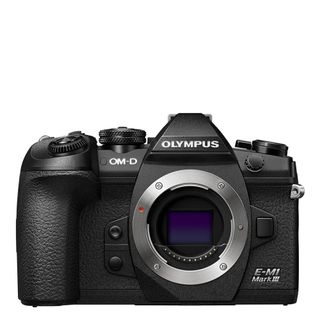
Best Micro Four-Thirds
Known and loved for being small and lightweight, the OM-D E-M1 Mark III has a whole array of handy features for astrophotography — including Starry Sky AF, Live Time and Live Composite modes, meaning you can even shoot astro handheld!
The best astrophotography cameras we recommend in 2024: Fully tested by our experts with hands-on, real-world experience
Why you can trust Live Science
Best astrophotography camera overall



Specifications
Reasons to buy
Reasons to avoid
✅ You're an advanced or professional user: The Z8 would likely be overkill for beginners or casual users.
✅ You want high resolution: The stacked 45MP sensor produces stunning high-resolution images.
❌ You want a lightweight camera: It's quite a big size increase from the Z7 II, so it wouldn't be the best choice for anyone looking for a lightweight travel camera — the Canon EOS R8, however, is the lightest in this list.
❌ You're a beginner: It'll be too expensive and too powerful for beginners. We think the Nikon Zf would be a better full-frame option for beginners.
🔎 Nikon Z8: With all the power and performance of the flagship Z9, but in a smaller and cheaper body, the Nikon Z8 is a market-leading mirrorless camera that professionals and intermediates with the budget will get use out of for years to come. ★★★★½
Known as the 'baby Z9', the Nikon Z8 is the best all-purpose camera that Nikon has ever made. It can handle anything and everything you throw at it, and then some. Astrophotography, wildlife, landscape, video — you name it. To put it simply, we think it's the best mirrorless camera for astrophotography on the market.
For astrophotography specifically, there are a few of the Z8s features that stood out to us when we reviewed the Nikon Z8. There's a night vision mode that dims the rear screen and only displays red pixels to help preserve your night vision, and Starlight View is fantastic for capturing subjects in the dark, being able to autofocus down to an incredible -9EV, as we mentioned in our Nikon Z8 review.
The general rule of thumb regarding sensor resolution when it comes to astrophotography is 'the more megapixels, the more noise', so the 45.7MP sensor in the Z8 may ring alarm bells in this aspect. But the beauty of a stacked sensor is not only a faster readout speed but also its improved noise handling, giving it better light-gathering ability. This means it performs much better in low light than cameras without a stacked sensor, so you can afford to increase the number of megapixels without compromising on image quality and noise. Plus, with an extended ISO 102,400, getting clean, detailed images in the dark is effortless even when we abused the ISO.
It isn't perfect, though — we'd have liked a fully articulating screen instead of the rather curious four-way tilting system, and we noticed that the autofocus can occasionally be a tad jumpy when compared to the best of the best on the market.
That said, the Z8 will most likely be overkill for beginners or casual users due to its power and price tag. The Z8 is one of, if not the best mirrorless camera on the market and we think it will only be found in the hands of professionals rather than anyone new to the hobby.
- Read our full Nikon Z8 review
| Attributes | Notes |
|---|---|
| Design | Fantastic build quality, but it's not a small camera. |
| Performance | Starlight mode enables autofocus detection down to an incredible -9EV. |
| Functionality | Features night vision mode for astrophotography. |
Best Sony camera for astrophotography





Specifications
Reasons to buy
Reasons to avoid
✅ You shoot various styles: The Sony A7 IV can turn its hand to many photographic styles, so it's great if you don't specialize in a particular genre.
✅ You're upgrading from crop-sensor: If you've surpassed 'beginner' status, we think it's a fantastic option to consider when you make the jump to full-frame.
❌ You prioritize video: Whilst it can shoot some lovely video, the 4K 30p cropped video may limit you as your skills grow. For videographers, we'd recommend the Sony A7S III.
❌ You want the latest tech: Even though it's only 3 years old (almost), some newer models are much more advanced in terms of features and autofocus.
🔎 Sony A7 IV: The Sony A7 IV is a fantastic all-rounder hybrid camera that performs incredibly well for both images and video, but it's not without its flaws. It gives solid performance in low light when you really need to push the ISO up. ★★★★
For a long time, the Sony A7 III was considered the camera to beat as there was nothing else like it when it was released back in 2018. Three years later in 2021, the Sony A7 IV came along with a whole bunch of updates and new features that improve on an already very impressive camera.
Design: They've introduced a number of small but effective upgrades in the design of the camera body. The first, and most obvious, is the addition of a fully articulating touchscreen. It's useful for everyday shooting, but it's particularly handy for astro if you're shooting in the dark at an awkward angle. They've also swapped a few of the buttons around, with the video record button being in a much more accessible place.
Performance: While we weren't able to test it out for astrophotography during our Sony A7 IV review, we did put the ISO handling through its paces inside a dark house with very poor lighting. Amazingly, we found the noise to become noticeably distracting at ISO 12,800, and even then, Lightroom's AI denoise feature got rid of the noise beautifully. It's unlikely you'd need to crank the ISO that high for astro, but we were very impressed with how it handled it.
Functionality: The dynamic range of the A7 IV is exceptional — we took it to the woods during the mid-afternoon sun and we could easily bring back the details from the harsh shadows and bright highlights. The autofocus is fast and reliable, although it has been outdone in some of the newer models with AI autofocus and Deep Learning.
We were a little underwhelmed by the resolution of the LCD screen and EVF, so hopefully they'll improve that in the next model — but that said, you can't expect it to be on the same level as the professional-grade models like the A1 and the A7R V unless you're willing to pay for it.
- Read our full Sony A7 IV review
| Attributes | Notes |
|---|---|
| Design | Feels great in the hand, and we love the fully articulating screen and updated button placements. |
| Performance | Incredible dynamic range, produces sharp and detailed images. |
| Functionality | 33MP sensor is a great improvement on the 24MP predecessor. |
Best lightweight camera for astrophotography





Specifications
Reasons to buy
Reasons to avoid
✅ You've surpassed 'beginner' status: It's a fantastic option for anyone making their first step into full-frame cameras once they've outgrown their beginner camera.
✅ You want to travel with it: As Canon's most lightweight full-frame mirrorless camera at just 1.02 lbs (461g), it's perfect for traveling or trekking to remote dark sky locations.
❌ You want a camera for professional use: The R8 is better suited to beginners and intermediate users than professionals. For pros, we'd recommend the Nikon Z8.
❌ You want two card slots: The R8 only has a single card slot, and the door to access it is in a pretty awkward place.
🔎 Canon EOS R8: The lightest and second-most affordable full-frame mirrorless camera from Canon lacks a few features but has cracking specs for the price and provides excellent value for those wanting a step up. ★★★★½
Design: If you're looking for a lightweight, compact camera that has great ISO handling and produces beautiful images, the Canon EOS R8 is the obvious choice. As we mentioned in our Canon EOS R8 review, it's Canon's lightest full-frame mirrorless camera at just 1.02 lbs (461g), so it's ideal for traveling and a great choice for anyone wanting to make the jump into the full-frame system without having to splurge out on the mid-range or premium models.
We did think the card slot was in a very awkward place, though. It's in with the battery with the door on the bottom of the camera, so if you need to change the card mid-shoot then you'll have to take the whole camera off the tripod in order to access it — plus there's only one card slot so this may happen more often unless you have a higher capacity card.
Performance: When we tested the R8 for astrophotography, we were astounded by how well it coped with high ISO levels — we found it could comfortably handle ISO 5000 and above with minimal noise, barely any color distortion and the images were bright and detailed. Any minor things we did find could easily be edited out in Lightroom. We thought it handled astro extremely well considering the low price, making it a fantastic option for beginners wanting to dip their toe into astrophotography.
Functionality: Naturally, for a camera that is aimed at more of a beginner/enthusiast market, it's going to have a few drawbacks in order to keep the price down. However, most of the 'it doesn't have this' or 'it doesn't have that' complaints that we have with this camera don't necessarily make a difference when you're using it for astrophotography specifically.
For instance, the R8 doesn't have image stabilization. No bother, many of the lenses do, plus you don't need it for astro anyway. It's also not fully weather-sealed. That's fine, you won't be doing astrophotography when it's raining (unless you get caught out unexpectedly). These caveats are worth taking into account if you want a camera for general-purpose usage, but for astrophotography, they certainly aren't dealbreakers.
Overall it's a very capable camera for astro, wildlife and general-purpose landscapes and portraiture thanks to its reliable autofocus, impressive burst speed and beautiful images. If you can live with its limitations, we think it's a great camera and certainly worthy of carrying with you on your travels.
- Read our full Canon EOS R8 review
| Attributes | Notes |
|---|---|
| Design | Canon's lightest full-frame camera. |
| Performance | Astounding ISO performance. |
| Functionality | Lacks image stabilization and complete weather-sealing, but neither of these matter too much for astro. |
Best entry-level full-frame camera for astrophotography












Specifications
Reasons to buy
Reasons to avoid
✅ You do a lot of low light shooting: The Nikon Zf can autofocus down to an unheard-of -10EV.
✅ You want to seriously hone your skills: If you have the budget for a very capable entry-level full-frame camera that will last a long time until you upgrade to a more powerful machine, the Zf is hard to beat.
❌ You shoot a lot of video: For video-heavy users, there are better options out there, like the Sony A7S III.
❌ You want more megapixels: By today's standards, 24.5MP isn't exactly anything to shout about. If you want a few more, the Sony A7 IV has 33MP and is only marginally more expensive.
🔎 Nikon Zf: As a full-frame mirrorless camera with all these specs and performance tucked away inside a stylish and immaculately designed exterior, it effortlessly blends beauty and brawn with its good looks and impressive performance. ★★★★½
Design: It has a plethora of on-body dials and controls reminiscent of a film SLR, and effortlessly balances style with substance thanks to its Deep Learning technology, reliable autofocus and excellent low-light performance. During our Nikon Zf review., we actually struggled to find anything 'wrong' with it without splitting hairs — only minor niggles like boosting the resolution, adding a tilting touchscreen and a second memory card slot, but for an entry-level camera, it's very hard to fault.
Performance: If you're looking for seriously impressive low-light performance in an entry-level full-frame camera, look no further than the Nikon Zf. Its low light sensitivity drops down to -10EV, which is the lowest of any Nikon camera to date, meaning it can lock on to subjects in the dark effortlessly without hunting around.
Even at ISO 8000, a 100% crop into the images shows negligible noise, minimal color distortion (a little magenta) and uniform grain across the frame. The images are obviously much cleaner at lower ISOs, but we thought the noise handling was impressive by anyone's standards.
Functionality: It's not just great for astro and low light shooting, it can shoot at 14FPS using the mechanical shutter, opening it up to wildlife and sports photography, too. Pair that with its reliable and accurate autofocus to switch between and track subjects, and you're onto a winner.
- Read our full Nikon Zf review
| Attributes | Notes |
|---|---|
| Design | Has a dial for just about anything you could possibly want. |
| Performance | Speedy and reliable autofocus, incredible low light performance. |
| Functionality | Can autofocus down to an insane -10EV. |
Best camera for astrovideography





Specifications
Reasons to buy
Reasons to avoid
✅ You focus on astro: The advantage of the 12.1MP sensor is that it'll produce much less noise than a higher megapixel sensor, which is ideal for astrophotography.
✅ You shoot a lot of video: It's ideal for video and online content creators thanks to its treasure chest of video-centric features.
❌ You want to do general stills photography: The 12.1MP sensor likely won't be detailed enough for more general photography use.
❌ You want to produce large prints: If you want to show off your work with large prints, consider investing in a higher-resolution camera like the Sony A7 IV or the Nikon Z8.
🔎 Sony A7S III: For the cleanest possible low-light performance, particularly when it comes to night and astrophotography, the A7S III is exceptionally compelling. And if you're a video-first shooter, don't even think twice about getting one. ★★★★½
Design: As a body designed primarily for video, it should come as no surprise that this is the ultimate astrovideography camera, as we noted in our Sony A7S III review. However, herein lies a compromise: the A7S III only features a 12.1MP sensor. This aids the camera's low light performance (since there are fewer pixels, each one is larger and able to gather more light), but means there is less detail if you want to print your photographs, and it's more likely to struggle if you want to turn your hand to more general styles of photography.
Performance: The Sony A7S III boasts near night vision performance, thanks to its ridiculous native ISO range of 80-102,400 (expandable to 409,600, though you'll never actually shoot that high) which also features dual native ISO. While most cameras have just one native ISO (the point at which performance is cleanest), the A7S III has two — one at ISO 640 and another at ISO 16,000 (though this varies in video modes).
Functionality: While this is the best camera for filming stars, though, there is one sting in the tail: the "star eater" phenomenon that plagued earlier Sony cameras (where overactive noise reduction would 'eat' stars misidentified as noise) occasionally rears its head when shooting video with wide angle lenses that are very sharp. That said, it can record unlimited, uncropped 4K video internally at up to 60p, or at 120p with a minimal 1.1x crop, all while retaining full autofocus performance.
It's a fantastic camera if you specialize in astrophotography or video, but if you want to shoot other styles of stills photography like wildlife, landscapes or portraits, you'll want to consider other more well-rounded options.
- Read our full Sony A7S III review
| Attributes | Notes |
|---|---|
| Design | Fully articulating screen and phenomenal viewfinder. |
| Performance | Great autofocus and insane low-light performance. |
| Functionality | Features dual native ISO. |
Best DSLR for astrophotography




Specifications
Reasons to buy
Reasons to avoid
✅ You're an advanced user: Not only is the price more suited to those with more experience, but DSLRs are typically less beginner-friendly than the newer mirrorless models with AI features built in.
✅ You shoot multiple disciplines: From astro to wildlife, portraits to video, the D850 can do it all.
❌ You want a futureproof investment: While the Nikon D850 is undoubtedly built to last, DSLRs are becoming much less common — we rate the Nikon Z8 as the best mirrorless camera.
❌ You want something small and portable: The large size and weight come with the territory of DSLRs, so if you want something compact and lightweight, we'd advise you to go for something like the Canon EOS R8.
🔎 Nikon D850: If you need both speed and resolution in a DSLR, the Nikon D850 is an absolute monster. Its 45.7MP stills are rich and detailed, giving you phenomenal image quality. It's the best DSLR full stop, in our opinion. ★★★★½
Design: The chunky DSLR design is a pleasure to handle, boasts weather sealing and also has a curtain mechanism for the optical viewfinder to stop unwanted light when shooting long exposures. It also has two card slots — one XQD / CFexpress and one SD.
A big bonus for astro is the inclusion of illuminated buttons, but only on the left-hand side of the camera — we'd love to have all the buttons light up, but being able to see key controls in the dark is a hugely welcome feature.
Performance: Its 45.7MP image sensor is back side illuminated (constructed so that the circuitry is on the underside, so as not to obstruct the front), which means that it has superior light-gathering capabilities with less noise and better all-round image quality. This works in tandem with a good, if not great, ISO range to produce enviable low-light performance. Like the Sony A7S III, the D850 also has dual native ISO — but at the less useful ISO 64 and ISO 400 sensitivities.
Functionality: Unlike other cameras on this list, the Nikon D850 doesn't have any dedicated astro features on paper. However, it is a fantastic DSLR with specs that lend themselves wonderfully to photographing the night sky — in fact, we think it's the best DSLR ever made, as we mentioned in our Nikon D850 review.
It has 9FPS burst shooting with the extra battery pack, or 7FPS without it — but when you consider that each file is 45.7MP, that's quite impressive. Plus, it has fully electronic silent shooting, meaning you can easily photograph wildlife without disturbing them.
- Read our full Nikon D850 review
| Attributes | Notes |
|---|---|
| Design | Fantastic build quality with great ergonomics. |
| Performance | Accurate stills autofocus and great battery life. |
| Functionality | Massive 45.7MP sensor for highly detailed stills. |
Best Micro Four-Thirds camera for astrophotography




Olympus OM-D E-M1 Mark III
Our expert review:
Specifications
Reasons to buy
Reasons to avoid
✅ You want something lightweight and compact: A huge advantage of MFT cameras are their smaller size and weight compared to crop sensor and full frame.
✅ You're a beginner: It has some pretty great features for beginners starting out in astro, plus the price isn't too high if you're new to the hobby.
❌ You're a professional: While it undoubtedly produces fantastic results, most professionals tend to go for full-frame— the Nikon Z8 is much more suited to advanced users.
❌ You want high resolution: The modest 20.4MP sensor could be a little low if you want highly detailed images — there are many options on this list with higher resolution sensors.
🔎 Olympus OM-D E-M1 Mark III: Even though it's half the sensor size of a full frame, it's certainly not half the camera. It has a bunch of handy astro-specific features, enabling you to nail focus on the stars and even shoot astro handheld! ★★★★
Design: Micro Four Thirds sensors are approximately 50% the size of full frame sensors, enabling the bodies (and lenses) to be much smaller, lighter and cheaper so your kit is compact enough to take anywhere — a big advantage in astrophotography if you are trekking out to remote dark sky locations. However, because the sensor is so much smaller, it has less surface area with which to absorb light. As the Olympus OM-D E-M1 Mark III proves, though, there is more to consider than just sensor size when it comes to astrophotography.
Performance: The E-M1 III features a unique Starry Sky AF algorithm, which can perform precision autofocus on even the smallest stars. The Accuracy Priority mode will help you nail focus when the camera is on a tripod, but the Speed Priority mode (which uses powerful image stabilization, good for up to 7.5 stops of compensation) means that you can shoot astrophotographs handheld with a wide-angle lens! We haven't managed to get our hands on this camera yet, but we look forward to putting it through its paces in a thorough review to see if it actually lives up to this claim!
Functionality: Coupled with the Live Time and improved Live Composite mode (which enables you to keep the shutter open for six hours, and only adds exposure when illumination changes to keep your images clean and evenly lit), capturing light trails is an absolute breeze. You can even use a USB source like a power bank to charge the camera while shooting. If size, weight and cost are considerations, the E-M1 Mark III offers powerful tools that make it a formidable choice despite the smaller sensor.
Note: We are currently reviewing the brand new OM System OM-1 Mark II, so keep your eyes peeled for a full review coming soon.
| Attributes | Notes |
|---|---|
| Design | Small and compact form factor. |
| Performance | Able to shoot astrophotography handheld! |
| Functionality | Quite modest megapixel count. |
Best color astrocam for astrophotography
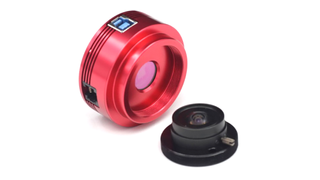
ZWO ASI183MC Pro
Our expert review:
Specifications
Reasons to buy
Reasons to avoid
✅ You focus on astrophotography: For enthusiastic astro-shooters, it's a fantastic buy as it can photograph all kinds of night-sky subjects.
❌ You want to shoot other discplines: This is a dedicated astro-camera, so it can't shoot other styles of photography.
🔎 ZWO ASI183MC Pro: If you're looking to take your first step into dedicated astronomical imaging cameras at an affordable price, you can’t go wrong with the ZWO ASI183MC Pro. ★★★★½
Design: Its high-sensitivity 1-inch 20.2MP CMOS sensor is made by Sony and is backside illuminated for clean and efficient imaging (aided by the cooling system to further reduce noise in long exposure imaging).
Performance: If you're looking to get into astrophotography of subjects like nebulas, galaxies and planets, the ZWO ASI183MC (with color sensor) is an affordable entry point to the world of expensive, cooled cameras. For long exposure work, you’ll need to get a suitable 12V power supply in order to run the camera cooling system — you can purchase one from ZWO, but it's worth noting that you'll need to source your own. But we found that even using shorter exposures, an incredible amount of detail is captured.
Functionality: With a claimed 12 stops of dynamic range, impressive spectral response (the amount of light that enters the telescope and is used by the sensor) and software finely tuned to reduce amplifier glow, the ASI183MC offers impressive performance for a variety of night sky subjects.
| Attributes | Notes |
|---|---|
| Design | Small and lightweight. |
| Performance | Captures beautiful images of planet and deep-sky objects. |
| Functionality | Requires dedicated software. |
Best astrophotography cameras: comparison
| Row 0 - Cell 0 | Camera type | Sensor size | Resolution | ISO range | Screen | Viewfinder | Max video resolution |
| Nikon Z8 | Mirrorless | Full frame | 45.7 Megapixels | 64 - 25,600 (expanded 32 - 102,400) | 3.2-inch tilt screen, 2,088,960 dots | Electronic, 3.69m dots | 8K 60p / 4K 120p |
| Sony A7 IV | Mirrorless | Full frame | 33 Megapixels | 100 — 51,200 (expanded 50 - 204,800) | 3-inch fully articulating, 1,036,800 dots | Electronic, 3,686,400 dots | 4K 30p uncropped / 4K 60p cropped |
| Canon EOS R8 | Mirrorless | Full frame | 24.2 Megapixels | 100 -102,400 (expanded 50 - 204,800) | 3-inch fully-articulating, 1.62m dots | Electronic, 9.44m dots | 4K UHD 60p |
| Nikon Zf | Mirrorless | Full frame | 24.5 Megapixels | 100-64,000 (expanded 204,800) | 3.2-inch fully articulating, 2.1m dots | Electronic, 3.69m dots | 4K 30p / FullHD 120p |
| Sony A7S III | Mirrorless | Full frame | 12.1 Megapixels | 80-102,400 (expanded 40-409,600) | 3-inch vari-angle touchscreen, 1.44m dots | Electronic, 9.44m dots | 4K 120p |
| Nikon D850 | DSLR | Full frame | 45.7 Megapixels | 64-25,600 (expanded 32-102,400) | 3.2-inch tilting touchscreen, 2.36m dots | Optical pentaprism | 4K 30p |
| Olympus OM-D E-M1 Mark III | Mirrorless | Micro Four-Thirds | 20.4 Megapixels | Low-25,600 (200 base) | 3-inch tilting touchscreen, 1.04m dots | Electronic, 2.36m dots | 4K 30p |
| ZWO ASI183MC Pro | CCD | 1-inch BSI CMOS | 20.2 Megapixels | N/A | N/A | N/A | 5496 x 3672 up to 19fps |
Best astrophotography cameras FAQ
What is the best camera for astrophotography?
Thanks to its stacked sensor, astro-specific features and incredible low-light performance, we think the Nikon Z8 is the best camera for astrophotography.
Are mirrorless or DSLR cameras better for astrophotography?
There's no right or wrong answer, but they do each have their own merits and limitations. Overall, mirrorless cameras are primarily the direction that most camera manufacturers are focusing on as we head towards the future, but that doesn't mean DSLRs don't still have their place.
Cameras come in two flavors: DSLR and mirrorless. DSLRs (digital single lens reflex) are chunkier cameras with a traditional mirror mechanism inside that flips out of the way to record an image. These tend to be cheaper and sturdier but are built on older technology. Mirrorless cameras are smaller and lighter cameras that ditch the mirror, giving you a live 'what you see is what you get' view of exactly what your photograph will look like, both on the rear screen and through the viewfinder.
Mirrorless cameras tend to be smaller and more lightweight, although due to the lack of power-hungry tech, DSLRs typically have a better battery life. There's also more lens availability with mirrorless cameras, and the autofocus and low-light sensitivity are constantly improving, whereas many camera brands no longer produce DSLRs at all.
What is an astrophotography camera?
Astrophotography cameras are imaging devices that enable you to capture clean long-exposure images of the night sky. This is achieved, primarily, by opening the camera's shutter long enough (usually around 30 seconds) to allow the dim starlight to be clearly visible through the black of night.
In order to accomplish this, you'll obviously need a camera with pristine image quality — though getting great photographs in low light conditions is one of the most challenging tasks that any camera can perform.
Thus, the best astrophotography cameras need to possess a number of critical characteristics: exceptional ISO performance (the sensitivity of the camera's image sensor), the ability to record low noise and high dynamic range, and a capable image processor to translate all this technology into the best possible image.
Some cameras even feature a specially modified IR filter on the sensor, which is designed to allow the infrared rays of deep space to be recorded by the camera (rather than being blocked, as they are by stock sensors in 99% of cameras).
Should I shoot in RAW for astrophotography?
In short, yes. RAW files give much more room for non-destructive editing, plus they capture more detail to play with than when you shoot in JPEG. They take up more space on your SD card than JPEGs do, but as all astrophotography images need some sort of editing, it's vital that you shoot your astro images in RAW to allow for that.
What ISO is best for astrophotography
This largely depends on the capabilities of your camera and how much light there is in the area you're shooting in. There's no one-size-fits-all answer, so you'll need to test your camera at different ISO levels to get a sense of where it's happiest. For a rough guide, start at ISO 1250 and go from there. If you're in a dark sky location, you can ramp the ISO up higher to capture more detail. If you're in a city or somewhere with more light pollution, go easy on the ISO to avoid excessive noise.
What lens is best for astrophotography?
The best lenses for photography are wide angle prime lenses — that being a lens with a fixed focal length without the ability to zoom. For focal length, anything below 24mm will work well for astro (but the wider the better), and for aperture, f/1.2, f/1.4 or f/1.8 are ideal. You'll only ever find these apertures in prime lenses — you can use wide-angle zoom lenses for astrophotography, provided it has a f/2.8 aperture.
What other equipment will I need for astrophotography?
Even with one of the best astrophotography cameras, though, you're still not quite set to start taking great pictures of the Milky Way; the camera body is just one part of the equation…
The right lens Firstly, you'll need an appropriate optic — the slow kit lens that came bundled with the camera won't really be up to the job. Invest in a fast, wide-angle lens — fast meaning an aperture with a large f-number (f/1.8 is ideal, no higher than f/2.8), and wide-angle meaning something ideally between 10mm and 24mm. Prime lenses (with a fixed focal length) tend to be both faster and sharper, though zoom lenses (with a variable focal length) offer greater versatility at the expense of speed.
A sturdy tripod Since you'll be shooting long exposures of 30 seconds or so, you're going to need something to keep your camera rock-steady. Travel tripods and vlogging-friendly Gorillapods will do in a pinch, but you should really invest in a full-size, sturdy tripod. You want to ensure that your camera is being held as rigid as possible since even a slight gust of wind will be visible when shooting a long exposure.
Remote shutter Even with a tripod, just the act of depressing the camera's shutter can cause vibrations. To combat this, invest in a remote shutter or shutter release cable — this enables you to control the shutter without physically touching the camera, and some even come with intervalometers that make it easier to shoot multiple exposures (handy for star trails). Alternatively, you can use the camera's self-timer to avoid camera shake when hitting the shutter.
Star tracker A motorized star tracker does exactly what it says on the tin: it tracks the movement of the stars, enabling your camera to move in sync to avoid unwanted trails when capturing long exposures. These are advanced tools of the trade, so once you've cut your teeth in astrophotography they'll offer you the next step to up your game.
How we test the best cameras for astrophotography
To ensure you're getting honest, up-to-date recommendations on the best cameras to buy here at LiveScience.com, we put every camera through a rigorous and thorough review to fully test each product. There are many aspects we consider during a review, from how well it functions or its design and construction or crucially, how well it performs in each specific genre of photography — in this instance, how well a camera performs for astrophotography.
Every model gets its own hands-on review and is tested either by our expert staff or freelance contributors, who are experts in their fields. This way, you get a fair review from a personal experience based on price, class and destined use. For example, comparing a 60MP full-frame mirrorless camera to a sleek little crop-sensor DSLR wouldn't be appropriate, even though each camera might be the best-performing product in its own class.
When testing, we consider whether or not it can produce top-quality images and high-resolution videos as well as what technology it features and of course, how easy it is to operate. Where we can, we also like to suggest additional kit that could improve the performance of a given camera.
With complete editorial independence, LiveScience.com are here to ensure you get the best buying advice on cameras and whether you should purchase a camera or not, making our buying guides and reviews reliable and transparent.
Sign up for the Live Science daily newsletter now
Get the world’s most fascinating discoveries delivered straight to your inbox.
The editor of Digital Camera World, James has 21 years experience as a magazine and web journalist. He has worked professionally in the photographic industry since 2014, when he started as an assistant to Damian McGillicuddy (who succeeded David Bailey as Principal Photographer for Olympus). In this time he shot for clients as diverse as Aston Martin Racing, Elinchrom and L'Oréal, in addition to shooting campaigns and product testing for Olympus, and providing training for professionals. This has led him to being a go-to expert on cameras and lenses, photographic and lighting tutorials, as well as industry analysis, news and rumors for publications such as Digital Camera Magazine, PhotoPlus: The Canon Magazine, N-Photo: The Nikon Magazine, Digital Photographer and Professional Imagemaker, as well as hosting workshops and demonstrations at The Photography Show. An Olympus (Micro Four Thirds) and Canon (full frame) shooter, he has a wealth of knowledge on cameras of all makes – and a particular fondness for vintage lenses and film cameras.